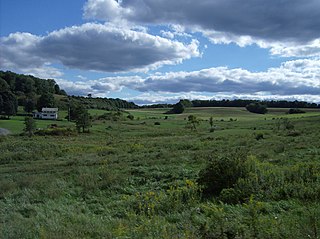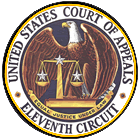
The Fourth Amendment to the United States Constitution is part of the Bill of Rights. It prohibits unreasonable searches and seizures. In addition, it sets requirements for issuing warrants: warrants must be issued by a judge or magistrate, justified by probable cause, supported by oath or affirmation, and must particularly describe the place to be searched and the persons or things to be seized.

The open-fields doctrine, in the U.S. law of criminal procedure, is the legal doctrine that a "warrantless search of the area outside a property owner's curtilage" does not violate the Fourth Amendment to the United States Constitution. However, "unless there is some other legal basis for the search," such a search "must exclude the home and any adjoining land that is within an enclosure or otherwise protected from public scrutiny."
In common law, the curtilage of a house or dwelling is the land immediately surrounding it, including any closely associated buildings and structures, but excluding any associated "open fields beyond", and also excluding any closely associated buildings, structures, or divisions that contain the separate intimate activities of their own respective occupants with those occupying residents being persons other than those residents of the house or dwelling of which the building is associated. It delineates the boundary within which a home owner can have a reasonable expectation of privacy and where "intimate home activities" take place. It is an important legal concept in certain jurisdictions for the understanding of search and seizure, conveyancing of real property, burglary, trespass, and land use planning.
Florida v. Riley, 488 U.S. 445 (1989), was a United States Supreme Court decision which held that police officials do not need a warrant to observe an individual's property from public airspace.
California v. Greenwood, 486 U.S. 35 (1988), was a case in which the Supreme Court of the United States held that the Fourth Amendment does not prohibit the warrantless search and seizure of garbage left for collection outside the curtilage of a home.
Maryland v. Garrison, 480 U.S. 79 (1986), is a United States Supreme Court case dealing with the Fourth Amendment of the United States Constitution and the extent of discretion given to police officers acting in good faith. The Court held that where police reasonably believe their warrant was valid during a search, execution of the warrant does not violate respondent's Fourth Amendment rights.
Expectation of privacy is a legal test which is crucial in defining the scope of the applicability of the privacy protections of the Fourth Amendment to the United States Constitution. It is related to, but is not the same as, a right to privacy, a much broader concept which is found in many legal systems. Overall, expectations of privacy can be subjective or objective.
United States v. Montoya De Hernandez, 473 U.S. 531 (1985), was a U.S. Supreme Court case regarding the Fourth Amendment's border search exception and balloon swallowing.
Oliver v. United States, 466 U.S. 170 (1984), is a United States Supreme Court decision relating to the open fields doctrine limiting the Fourth Amendment to the United States Constitution.

United States v. Hatch, 931 F.2d 1478, cert. denied, 502 U.S. 883 (1991) is a United States Court of Appeals for the Eleventh Circuit court decision relating to the open fields doctrine limiting the scope of the Fourth Amendment of the U.S. Constitution.

United States v. Pace, 955 F.2d 270, cert. denied, 502 U.S. 883 (1992) is a United States Court of Appeals for the Fifth Circuit court decision relating to the open fields doctrine limiting the scope of the Fourth Amendment of the U.S. Constitution.
California v. Ciraolo, 476 U.S. 207 (1986), was a case decided by the United States Supreme Court, in which it ruled that warrantless aerial observation of a person's backyard did not violate the Fourth Amendment to the United States Constitution.
Minnesota v. Dickerson, 508 U.S. 366 (1993), was a decision by the Supreme Court of the United States. The Court unanimously held that, when a police officer who is conducting a lawful patdown search for weapons feels something that plainly is contraband, the object may be seized even though it is not a weapon. By a 6-to-3 vote, however, the court held that the officer in this case had gone beyond the limits of a lawful patdown search before he could determine that the object was contraband, making the search and the subsequent seizure unlawful under the Fourth Amendment.
United States v. Karo, 468 U.S. 705 (1984), was a United States Supreme Court decision related to the Fourth Amendment protection from unreasonable search and seizure. It held that use of an electronic beeper device to monitor a can of ether without a warrant constituted an unlawful search. However, the Court upheld the conviction of Karo and his accomplices, stating that the warrant affidavit contained enough information not derived from the unlawful use of the beeper to provide sufficient basis for probable cause.

In the law of the United States, the mere evidence rule was a historical doctrine that defined the scope of the Fourth Amendment to the United States Constitution.
United States v. Knotts, 460 U.S. 276 (1983), was a United States Supreme Court case regarding the use of an electronic surveillance device. The defendants argued that the use of this device was a Fourth Amendment violation. The device in question was described as a beeper that could only be tracked from a short distance. During a single trip, officers followed a car containing the beeper, relying on beeper signal to determine the car's final destination. The Court unanimously held that since the use of such a device did not violate a legitimate expectation of privacy there was no search and seizure and thus the use was allowed without a warrant. It reasoned that a person traveling in public has no expectation of privacy in one's movements. Since there was no search and seizure there was not a Fourth Amendment violation.
United States v. Jones, 565 U.S. 400 (2012), was a landmark United States Supreme Court case which held that installing a Global Positioning System (GPS) tracking device on a vehicle and using the device to monitor the vehicle's movements constitutes a search under the Fourth Amendment.

Florida v. Jardines, 569 U.S. 1 (2013), was a United States Supreme Court case which resulted in the decision that police use of a trained detection dog to sniff for narcotics on the front porch of a private home is a "search" within the meaning of the Fourth Amendment to the United States Constitution, and therefore, without consent, requires both probable cause and a search warrant.
United States v. Watson, 423 U.S. 411 (1976), was a case decided by the Supreme Court of the United States that decided that a warrantless arrest in public and consenting to a vehicle search did not violate the Fourth Amendment.
Collins v. Virginia, No. 16-1027, 584 U.S. ___ (2018), was a case before the US Supreme Court involving search and seizure. At issue was whether the Fourth Amendment's motor vehicle exception permits a police officer uninvited and without a warrant to enter private property, approach a house, and search a vehicle parked a few feet from the house that is otherwise visible from off the property. In an 8–1 judgement, the Supreme Court ruled that the automobile exception does not apply to vehicles parked within the home or the curtilage of a private homeowner.






